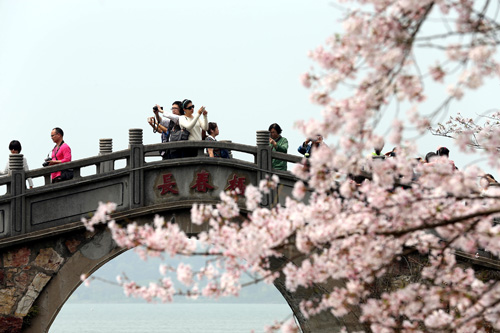Cherry flowers bloom in friendship
By Cang Wei in Wuxi, Jiangsu (China Daily) Updated: 2015-04-02 07:44
 |
Turtlehead Park in Wuxi, Jiangsu province, which is often considered China's best place to enjoy cherry blossoms, has thousands of cherry trees in bloom that represent the friendship between China and Japan.
The park has more than 30,000 cherry trees in its 650,000-square-meter cherry valley. The trees - more than 80 kinds - will stay in bloom until late April.
The buildings, streams and bridges in the valley combine Chinese and Japanese characteristics. It is also one of the world's three largest venues to appreciate cherry blossoms and is China's largest for research on cherry trees, according to the local government.
Wang Jinjian, vice-mayor of Wuxi, said at the opening ceremony of Wuxi International Cherry Blossom Weeks, which will continue until April 15, that the flourishing cherry trees in the valley resulted from the hard work of both China and Japan.
"The trees have developed from 1,500 in 1988 to more than 30,000 this year," Wang said. "Many nongovernmental friendship organizations and people from the two countries were passionately devoted to the establishment of the valley.
"We hope that the nongovernmental cooperation between the two sides can be extended to more areas, and that the friendship can be cherished by the young generation."
In 1986, some Japanese friends formed a committee in cooperation with the Wuxi Association for Friendship with Foreign Countries, and Japan initiated nongovernmental communication by presenting cherry saplings, the local foreign affairs office said.
In 1988, a group of 409 Japanese planted the first group of 1,500 cherry saplings together with Wuxi residents.
Every year, people from Japan visit and plant more saplings in the valley.
According to the Wuxi foreign affairs office, the groups have communicated frequently in economic, educational and cultural areas for years. The city received help from Japan in many fields, including flood rescue, establishing sports centers and the training of social workers.
- Govt encourages people to work 4.5 days a week
- Action to be taken as HIV cases among students rise
- Debate grows over reproductive rights
- Country's first bishop ordained in 3 years
- China builds Tibetan Buddhism academy in Chengdu
- Authorities require reporting of HIV infections at schools
- Typhoon Soudelor kills 14 in East China
- Police crack down on overseas gambling site
- Debate over death penalty for child traffickers goes on
- Beijing to tighten mail security for war anniversary







